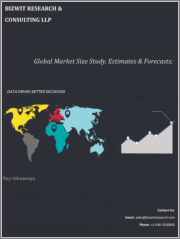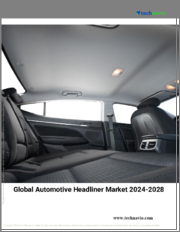
|
시장보고서
상품코드
1381817
세계의 자동차용 헤드라이너 시장 규모 조사 및 예측 : 차량 유형별, 재료 유형별, 지역별 분석(2023-2030년)Global Automotive Headliner Market Size study & Forecast, by Vehicle Type (Passenger and Commercial), by Material Type (Fabric, Polyester and Plastic) and Regional Analysis, 2023-2030 |
||||||
자동차용 헤드라이너는 자동차 인테리어에 없어서는 안 될 부품으로, 내부 경질 기판과 일반적으로 폼으로 된 천으로 된 외장재로 구성됩니다.
그 주요 목적은 탑승자에게 더 많은 편안함과 안전성을 제공하는 동시에 차량 내부의 미학을 향상시키는 것입니다. 헤드 라이너는 충격을 흡수하고 차량 내부의 배선을 숨기고 차량 천장의 전체적인 외관을 개선하여 기능적 및 시각적 역할을 수행합니다.
자동차용 헤드라이너 시장의 성장을 촉진하는 몇 가지 요인이 있을 것으로 예상됩니다. 먼저, 세계 자동차 수요 증가와 인구 변화로 인해 헤드 라이너와 같은 내장재 강화에 대한 수요가 증가하고 있습니다. 또한, 자동차의 안전과 환경 영향에 대한 우려가 높아지면서 규제와 기준이 강화되고 있으며, 이는 보다 안전하고 지속가능한 헤드 라이너 솔루션에 대한 수요를 촉진하고 있습니다.
이 시장은 또한 저연비 차량에 대한 수요 증가와 전기자동차의 보급 확대에 영향을 받고 있습니다. 소비자들이 연비와 친환경을 우선시하는 가운데, 자동차 제조사들은 경량화 및 친환경 소재를 헤드 라이너에 적용하는 방안을 모색하고 있으며, 이는 시장 성장에 기여하고 있습니다. 국제자동차산업협회(OICA)에 따르면 2020년 세계 자동차 판매량은 약 6,400만대로 2019년 대비 약 14% 감소했습니다. 이 감소는 주로 COVID-19 사태가 자동차 산업에 미친 영향 때문입니다. 그러나 전기자동차(EV) 판매량은 최근 몇 년 동안 눈에 띄는 성장세를 보이고 있습니다. 친환경 자동차에 대한 수요 증가, 정부의 인센티브, 전기차 기술 향상 등이 이러한 성장에 기여하고 있습니다. 그러나 전 세계 자동차 판매량에서 EV가 차지하는 비중은 여전히 상대적으로 작습니다.
세계 자동차용 헤드라이너 시장 조사에서 고려된 주요 지역은 아시아태평양, 북미, 유럽, 라틴아메리카, 중동 및 아프리카이며, 2022년에는 아시아태평양이 가장 큰 시장 점유율을 차지하고 예측 기간 동안 가장 높은 CAGR로 시장을 지배할 것으로 예상됩니다. 이는 이 지역의 급속한 인구 증가와 도시화 진행 등의 요인에 기인하는 것으로 보입니다. 중국은 자동차용 헤드라이너 제조 기지로서의 지위와 높은 승용차 수요로 인해 아시아태평양에서 가장 빠르게 성장하는 시장이 될 것으로 예상됩니다.
북미는 자동차용 헤드라이너 시장에서 두 번째로 큰 지역으로 예측 기간 동안 꾸준한 성장이 예상됩니다. 이러한 성장을 촉진하는 요인으로는 고급차 판매 증가와 차량 경량화에 중점을 둔 규제 등이 있습니다. 유럽 시장도 큰 비중을 차지할 것으로 전망 유럽 시장은 승용차 및 고급차 판매량 증가의 수혜를 받을 것으로 보입니다. 또한, 이 지역에는 여러 주요 시장 기업이 존재한다는 점도 시장 성장에 기여할 것으로 예상됩니다.
이 조사의 목적은 최근 몇 년간 다양한 부문과 국가의 시장 규모를 파악하고 향후 몇 년간 시장 규모를 예측하는 것입니다. 이 보고서는 조사 대상 국가의 산업의 질적, 양적 측면을 모두 포함하도록 설계되었습니다.
또한 시장의 미래 성장을 규정하는 촉진요인과 과제와 같은 중요한 측면에 대한 자세한 정보도 제공합니다. 또한, 주요 기업의 경쟁 상황과 제품 제공에 대한 상세한 분석과 함께 이해관계자들이 투자할 수 있는 미시적 시장에서의 잠재적 기회도 포함합니다.
목차
제1장 주요 요약
제2장 자동차용 헤드라이너 세계 시장 정의와 범위
- 조사 목적
- 시장 정의와 범위
- 산업의 진화
- 조사 범위
- 조사 대상 연도
- 통화 환산율
제3장 자동차용 헤드라이너 세계 시장 역학
- 자동차용 헤드라이너 시장 영향 분석(2020-2030년)
- 시장 성장 촉진요인
- 프리미엄 부문 차에 대한 수요 증가
- 인테리어 스타일링, 지각 품질, 편리성 기능에 대한 수요 증가
- 시장 과제
- 첨단 헤드라이너 및 오버헤드 시스템의 고비용
- 시장 기회
- 자율주행차에 대한 수요 증가
- 자동차 산업의 전기자동차의 등장
- 시장 성장 촉진요인
제4장 자동차용 헤드라이너 세계 시장 : 산업 분석
- Porter's 5 Force 모델
- 공급 기업의 교섭력
- 구매자의 교섭력
- 신규 참여업체의 위협
- 대체품의 위협
- 경쟁 기업 간의 경쟁 관계
- Porter's 5 Force 영향 분석
- PEST 분석
- 정치
- 경제
- 사회
- 기술
- 환경
- 법률
- 주요 투자 기회
- 주요 성공 전략
- COVID-19 영향 분석
- 파괴적 동향
- 업계 전문가의 관점
- 애널리스트의 결론과 제안
제5장 자동차용 헤드라이너 세계 시장 : 차종별
- 시장 현황
- 자동차용 헤드라이너 세계 시장 : 차종별, 실적 - 잠재성 분석
- 자동차용 헤드라이너 세계 시장 : 차종별 추정·예측, 2020-2030년
- 자동차용 헤드라이너 시장, 하위 부문별 분석
- 승용차
- 상용차
제6장 자동차용 헤드라이너 세계 시장 : 재료 유형별
- 시장 현황
- 자동차용 헤드라이너 세계 시장 : 재료 유형별, 실적 - 잠재성 분석
- 자동차용 헤드라이너 세계 시장 : 재료 유형별 추정·예측, 2020-2030 매년
- 자동차용 헤드라이너 시장 하위 부문 분석
- 패브릭
- 폴리에스테르
- 플라스틱
제7장 자동차용 헤드라이너 세계 시장 : 지역별 분석
- 주요 국가
- 주요 신흥 국가
- 자동차용 헤드라이너 시장, 지역별 시장 현황
- 북미
- 미국
- 캐나다
- 유럽의 자동차용 헤드라이너 시장 현황
- 영국
- 독일
- 프랑스
- 스페인
- 이탈리아
- 기타 유럽
- 아시아태평양의 자동차용 헤드라이너 시장 현황
- 중국
- 인도
- 일본
- 호주
- 한국
- 기타 아시아태평양
- 라틴아메리카의 자동차용 헤드라이너 시장 현황
- 브라질
- 멕시코
- 중동 및 아프리카
- 사우디아라비아
- 남아프리카공화국
- 기타 중동 및 아프리카
제8장 경쟁 정보
- 주요 기업 SWOT 분석
- 주요 시장 전략
- 기업 개요
- Adient
- 주요 정보
- 개요
- 재무(데이터 가용성에 따라 다름)
- 제품 개요
- 최근의 동향
- Atlas Roofing Corporation
- Grupo Antolin
- Harodite Industries
- Howa-Tramico
- IAC Group
- Industrialesud
- Lear Corporation
- Motus Integrated Technologies
- Sage Automotive Interiors
- Adient
제9장 조사 과정
- 조사 과정
- 데이터 마이닝
- 분석
- 시장 추정
- 검증
- 출판
- 조사 속성
- 조사 가정
Automotive headliners are integral components of a vehicle's interior, consisting of an inner rigid substrate and an outer material typically made of fabric with foam backing. Their primary purpose is to enhance the interior aesthetics of vehicles while providing additional comfort and safety to occupants. Headliners serve both functional and visual roles by absorbing shocks, hiding interior wires, and improving the overall appearance of the vehicle's ceiling.
Several factors are expected to drive the growth of the automotive headliner market. Firstly, the increased demand for automobiles globally, coupled with changing demographic trends, is creating a higher need for interior enhancements such as headliners. Additionally, the growing concerns regarding vehicle safety and environmental impact have led to stricter regulations and standards, which, in turn, drive the demand for safer and more sustainable headliner solutions.
The market is also influenced by the rising demand for fuel-efficient vehicles and the growing adoption of electric vehicles. As consumers prioritize fuel efficiency and environmental friendliness, manufacturers are exploring lightweight and eco-friendly materials for headliners, contributing to market growth. According to the International Organization of Motor Vehicle Manufacturers (OICA), global car sales reached approximately 64 million units in 2020, a decline of around 14% compared to 2019. The decline was primarily due to the impact of the COVID-19 pandemic on the automotive industry. However, Electric vehicle (EV) sales have been experiencing notable growth in recent years. The increasing demand for environmentally friendly vehicles, government incentives, and improvements in EV technology have contributed to this growth. However, Evs still represent a relatively small portion of overall global vehicle sales.
The key regions considered for the Global Automotive Headliner Market study includes Asia Pacific, North America, Europe, Latin America, and Middle East & Africa. In 2022, the Asia Pacific region held the largest market share, and it is expected to continue dominating the market with the highest compound annual growth rate (CAGR) during the forecast period. This can be attributed to factors such as rapid population growth and increasing urbanization in the region. China is anticipated to be the fastest-growing market within the Asia Pacific region due to its status as a manufacturing hub for automotive headliners and its high demand for passenger vehicles.
North America is expected to be the second-largest region for the automotive headliner market, with steady growth projected throughout the forecast period. Factors driving this growth include increased sales of luxury vehicles and regulations focused on vehicle weight reduction. Europe is also expected to hold a significant share of the market The market in Europe will benefit from the rising sales of both passenger vehicles and luxury vehicles. Additionally, the presence of several major market players in the region is expected to contribute to market growth.
Major market player included in this report are:
- Adient
- Atlas Roofing Corporation
- Grupo Antolin
- Harodite Industries
- Howa-Tramico
- IAC Group
- Industrialesud
- Lear Corporation
- Motus Integrated Technologies
- Sage Automotive Interiors
Global Automotive Headliner Market Report Scope:
- Historical Data - 2020 - 2021
- Base Year for Estimation - 2022
- Forecast period - 2023-2030
- Report Coverage - Revenue forecast, Company Ranking, Competitive Landscape, Growth factors, and Trends
- Segments Covered - Vehicle Type, Material Type, Region
- Regional Scope - North America; Europe; Asia Pacific; Latin America; Middle East & Africa
- Customization Scope - Free report customization (equivalent up to 8 analyst's working hours) with purchase. Addition or alteration to country, regional & segment scope*
The objective of the study is to define market sizes of different segments & countries in recent years and to forecast the values to the coming years. The report is designed to incorporate both qualitative and quantitative aspects of the industry within countries involved in the study.
The report also caters detailed information about the crucial aspects such as driving factors & challenges which will define the future growth of the market. Additionally, it also incorporates potential opportunities in micro markets for stakeholders to invest along with the detailed analysis of competitive landscape and product offerings of key players. The detailed segments and sub-segment of the market are explained below:
By Vehicle Type:
- Passenger
- Commercial
By Material Type:
- Fabric
- Polyester
- Plastic
By Region:
- North America
- U.S.
- Canada
- Europe
- UK
- Germany
- France
- Spain
- Italy
- ROE
- Asia Pacific
- China
- India
- Japan
- Australia
- South Korea
- RoAPAC
- Latin America
- Brazil
- Mexico
- Middle East & Africa
- Saudi Arabia
- South Africa
- Rest of Middle East & Africa
Table of Contents
Chapter 1. Executive Summary
- 1.1. Market Snapshot
- 1.2. Global & Segmental Market Estimates & Forecasts, 2020-2030 (USD Billion)
- 1.2.1. Automotive headliner Market, by Region, 2020-2030 (USD Billion)
- 1.2.2. Automotive headliner Market, by Vehicle Type, 2020-2030 (USD Billion)
- 1.2.3. Automotive headliner Market, by Material Type, 2020-2030 (USD Billion)
- 1.3. Key Trends
- 1.4. Estimation Methodology
- 1.5. Research Assumption
Chapter 2. Global Automotive headliner Market Definition and Scope
- 2.1. Objective of the Study
- 2.2. Market Definition & Scope
- 2.2.1. Industry Evolution
- 2.2.2. Scope of the Study
- 2.3. Years Considered for the Study
- 2.4. Currency Conversion Rates
Chapter 3. Global Automotive headliner Market Dynamics
- 3.1. Automotive headliner Market Impact Analysis (2020-2030)
- 3.1.1. Market Drivers
- 3.1.1.1. Increase in demand for premium segment vehicles
- 3.1.1.2. Rising demand for interior styling, perceived quality, and convenience features
- 3.1.2. Market Challenges
- 3.1.2.1. High cost of advanced headliner and overhead systems
- 3.1.3. Market Opportunities
- 3.1.3.1. Increase in demand for autonomous vehicles
- 3.1.3.2. Advent of electric vehicles in the automotive industry
- 3.1.1. Market Drivers
Chapter 4. Global Automotive headliner Market Industry Analysis
- 4.1. Porter's 5 Force Model
- 4.1.1. Bargaining Power of Suppliers
- 4.1.2. Bargaining Power of Buyers
- 4.1.3. Threat of New Entrants
- 4.1.4. Threat of Substitutes
- 4.1.5. Competitive Rivalry
- 4.2. Porter's 5 Force Impact Analysis
- 4.3. PEST Analysis
- 4.3.1. Political
- 4.3.2. Economical
- 4.3.3. Social
- 4.3.4. Technological
- 4.3.5. Environmental
- 4.3.6. Legal
- 4.4. Top investment opportunity
- 4.5. Top winning strategies
- 4.6. COVID-19 Impact Analysis
- 4.7. Disruptive Trends
- 4.8. Industry Expert Perspective
- 4.9. Analyst Recommendation & Conclusion
Chapter 5. Global Automotive headliner Market, by Vehicle Type
- 5.1. Market Snapshot
- 5.2. Global Automotive headliner Market by Vehicle Type, Performance - Potential Analysis
- 5.3. Global Automotive headliner Market Estimates & Forecasts by Vehicle Type 2020-2030 (USD Billion)
- 5.4. Automotive headliner Market, Sub Segment Analysis
- 5.4.1. Passenger
- 5.4.2. Commercial
Chapter 6. Global Automotive headliner Market, by Material Type
- 6.1. Market Snapshot
- 6.2. Global Automotive headliner Market by Material Type, Performance - Potential Analysis
- 6.3. Global Automotive headliner Market Estimates & Forecasts by Material Type 2020-2030 (USD Billion)
- 6.4. Automotive headliner Market, Sub Segment Analysis
- 6.4.1. Fabric
- 6.4.2. Polyester
- 6.4.3. Plastic
Chapter 7. Global Automotive headliner Market, Regional Analysis
- 7.1. Top Leading Countries
- 7.2. Top Emerging Countries
- 7.3. Automotive headliner Market, Regional Market Snapshot
- 7.4. North America Automotive headliner Market
- 7.4.1. U.S. Automotive headliner Market
- 7.4.1.1. Vehicle Type breakdown estimates & forecasts, 2020-2030
- 7.4.1.2. Material Type breakdown estimates & forecasts, 2020-2030
- 7.4.2. Canada Automotive headliner Market
- 7.4.1. U.S. Automotive headliner Market
- 7.5. Europe Automotive headliner Market Snapshot
- 7.5.1. U.K. Automotive headliner Market
- 7.5.2. Germany Automotive headliner Market
- 7.5.3. France Automotive headliner Market
- 7.5.4. Spain Automotive headliner Market
- 7.5.5. Italy Automotive headliner Market
- 7.5.6. Rest of Europe Automotive headliner Market
- 7.6. Asia-Pacific Automotive headliner Market Snapshot
- 7.6.1. China Automotive headliner Market
- 7.6.2. India Automotive headliner Market
- 7.6.3. Japan Automotive headliner Market
- 7.6.4. Australia Automotive headliner Market
- 7.6.5. South Korea Automotive headliner Market
- 7.6.6. Rest of Asia Pacific Automotive headliner Market
- 7.7. Latin America Automotive headliner Market Snapshot
- 7.7.1. Brazil Automotive headliner Market
- 7.7.2. Mexico Automotive headliner Market
- 7.8. Middle East & Africa Automotive headliner Market
- 7.8.1. Saudi Arabia Automotive headliner Market
- 7.8.2. South Africa Automotive headliner Market
- 7.8.3. Rest of Middle East & Africa Automotive headliner Market
Chapter 8. Competitive Intelligence
- 8.1. Key Company SWOT Analysis
- 8.1.1. Company 1
- 8.1.2. Company 2
- 8.1.3. Company 3
- 8.2. Top Market Strategies
- 8.3. Company Profiles
- 8.3.1. Adient
- 8.3.1.1. Key Information
- 8.3.1.2. Overview
- 8.3.1.3. Financial (Subject to Data Availability)
- 8.3.1.4. Product Summary
- 8.3.1.5. Recent Developments
- 8.3.2. Atlas Roofing Corporation
- 8.3.3. Grupo Antolin
- 8.3.4. Harodite Industries
- 8.3.5. Howa-Tramico
- 8.3.6. IAC Group
- 8.3.7. Industrialesud
- 8.3.8. Lear Corporation
- 8.3.9. Motus Integrated Technologies
- 8.3.10. Sage Automotive Interiors
- 8.3.1. Adient
Chapter 9. Research Process
- 9.1. Research Process
- 9.1.1. Data Mining
- 9.1.2. Analysis
- 9.1.3. Market Estimation
- 9.1.4. Validation
- 9.1.5. Publishing
- 9.2. Research Attributes
- 9.3. Research Assumption



















